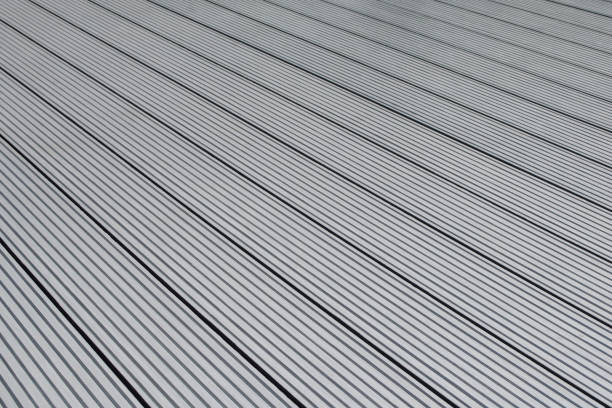
Have you made up your mind to construct an incredible new deck? There is a strong chance that you are becoming confused by the numerous deck boards and decking materials that are currently available to you. What kind of decking material is the most desirable? Is it worthwhile to pay a higher premium for composite decking? In this post, we will discuss the many materials that are available for you to employ in the construction of your new deck.
Composite Decking Material
Decks can have both their aesthetic and their durability improved by using composite decking boards, which are made up of two or more components (usually wood fibres and one or more types of plastic). Although composite decking is cut and fastened in the same manner as wood, its performance is superior due to the absence of natural materials’ inherent flaws. As a consequence of this, composite decking has a longer lifespan and requires less maintenance than traditional decking materials, such as power-washing, sanding, and staining.
Frequently, recycled or reclaimed materials are used in the production of composite decking boards. These boards are typically composed of polyethylene (HDPE or LDPE) or PVC (polyvinyl chloride) that has been combined with wood fiber, rice hulls, or other fillers, as well as a mixture of chemical additives. While some composite goods may not include any recycled materials, others can contain as much as 95% recycled content due to the manufacturing process. Since the majority of manufacturers have optimized their processing procedures, the difference in recycled content is more of an environmental matter than a worry for performance.
Pros
- Low maintenance; you don’t have to paint or stain it.
- Friendly to the environment
- There are no splinters or rot.
- Warranties and installation guides from the maker
Cons
- Higher initial cost
Wood Decking Material
It’s possible that the first material that comes to mind is wood, which was the first and is still the most common alternative today. Wood is an excellent choice due to the fact that it is durable and the assembly is straightforward. However, if you have wood decks, you will be responsible for the annual cleaning and maintenance of those decks. If you fail to maintain your wooden deck, you should anticipate it to splinter, distort, and possibly even decay after some time has passed. Because the color of wood also tends to fade with time, you will need to re-stain it approximately once every two to three years in order to maintain it looking as good as new. If you decide to construct your deck out of wood, the next step is to select the species of wood that you want to work with. The natural hue of cedar is really attractive, and it has a very long lifespan in comparison to other options. Cedar is a highly popular choice. Cedar wood is also exceptionally hardy and long-lasting. Because it is resistant to both mold and insects, pressure-treated wood is another material that is frequently used for the framing of decks. When combined, cedar and pressure-treated wood provide an extraordinary deck that can provide years of use and satisfaction.
Pros
- Material for decking that is naturally durable
- Simple installation
- Lower initial costs
Cons
- Regular upkeep and cleaning on an annual basis
- Regular washing or painting
- A shorter lifespan in comparison to alternatives
PVC / Plastic Decking Material
PVC plastic decking is a fantastic alternative for your deck because it requires almost no upkeep at all. When it comes to appearance, vinyl decking gives a wide variety of choices in terms of colour and design to simulate the authentic look of lumber decking. PVC decking is relatively lightweight, which makes it easier to work with and move about than other decking materials. The greatest disadvantage of PVC decking is the higher price it commands in comparison to its more affordable competitors; however, when you include in the money you will save on the virtually nonexistent or extremely infrequent need for maintenance, the larger initial cost is somewhat reduced.
Pros
- Not too heavy
- Cuts easily
- Can be heated and shaped as needed
Cons
- Migration of Plasticizers: The plasticizer chemicals contained within vinyl migrate out of the body and are absorbed by the materials around it, causing the materials to become discolored.
Adding a deck to your home is an investment that will increase its value, regardless of whether you use natural wood or composite materials. And while price is frequently the most significant factor to take into account, it is equally essential to be aware of the value that is being offered.
You have undoubtedly already noticed that the initial cost of composite decking boards is typically more than the cost of real wood decking boards. However, because of the recent spike in the price of wood, the disparity in prices has shrunk quite a little in recent times. When the overall cost of ownership is considered, there is less of a price difference between the two options. Maintaining a deck made of wood involves far more effort and expense than maintaining a deck made of composite material, which only requires an occasional washing with a mild detergent and water. In addition, the majority of composite items come with guarantees that last multiple decades.
To maintain the deck’s functionality and structural integrity, it is necessary to undertake routine maintenance tasks such as power washing, sanding, and sealing or staining. Additionally, any boards that have become rotting or broken must be fixed or replaced. The expenditures will add up whether you hire a contractor or perform the job yourself, regardless of which option you choose. When all of these expenditures are considered, a deck made of composite material may end up costing less than one made of wood over the course of its lifetime.


